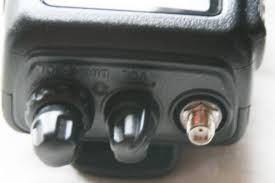The plug that is used for terminating cables between the receiver, transmitter or transceiver and the antenna is generally referred to as the RF connector because it carries the Radio Frequency signal to/from the equipment.
In addition to mating the radio to the antenna via a transmission line (usually a coaxial cable) it may also used on RF test equipment (antenna analyzer, power and SWR meters, spectrum analyzer) and dummy loads. All hams should be familiar with different RF connectors so we’ll give a brief high-level description here.
Good news! There are only four common types of RF connector used in ham radio:
PL-259


By far the most common RF connector, the PL-259 is used to connect most all modern HF transceivers and VHF/UHF mobile rigs to the antenna. The PL designation stands for plug and the 259 is an old US Signal Corps assignment. It has a male center pin and female thread.

The mating receptacle found on the radios and equipment is known as a SO-239. SO for socket, it features a female center receptacle and has male threads.

The PL-259 and SO-239 combination (details here) is frequently referred to as a “UHF connector” although this designation comes from the 1930s when UHF was considered anything above 30MHz. It has performance limitations above 100MHz so other connector types are more suitable for true UHF use.

N-type


Physically similar to the PL-259/SO-239 pair, the N connector can handle high power levels above 300MHz and is commonly found on UHF radios and test equipment. (details here)
Be aware that there are 50Ω and 75Ω versions available and the two should not be mixed.
BNC
The BNC (Bayonet Neill–Concelman) is a miniature quarter-turn coaxial cable connector.

Its small size makes it suitable for smaller, lower-power radios and it can handle RF up to microwave frequencies . It is less common on modern transceivers but can still be found on older handhelds radios (HTs). (details here)


BNCs are used for many other applications besides carrying RF on radios. It is commonly found on test equipment and is used for some audio and video interconnect.
Like the N-type, pay attention to not mix or confuse 50Ω and 75Ω versions.
SMA
The SMA (Sub-miniature version A) connector supports RF up to microwave frequencies but due to its small size it has limited power-handling capability.


For this reason it is commonly found on HTs and other low-power radio gear. You will also see them on WiFi routers and such equipment.
Note that there is a reverse gender version of the SMA and this is found mainly on some cheap Chinese HTs.


With all these coaxial cable RF connector types you can buy pre-made cables or save money by building your own (DIY). When fabricating your own cables, consider coax size and characteristics. The RF connector will always have different versions to accommodate varying cable diameter.

Another winner, Jim. Great Pix and Refs.
LikeLike